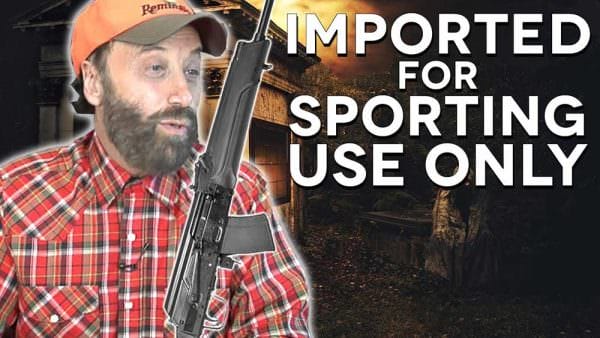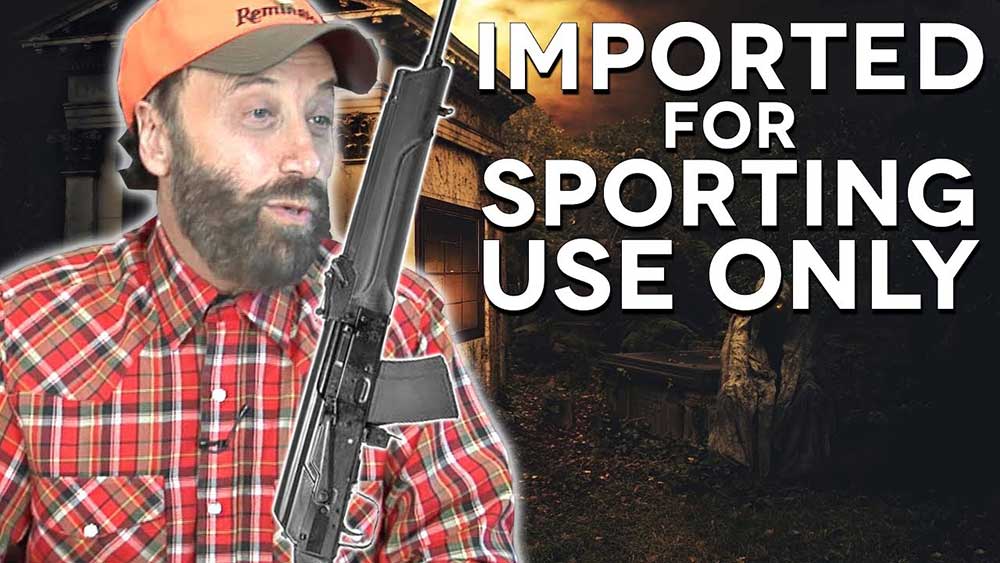USA – -(Ammoland.com)- Welcome back to The Legal Brief, the show where we CRUSH the various legal myths and misinformation surrounding various areas of the gun world. I’m your host Adam Kraut and today we’re talking about the hated Sporting Purposes Exemption.
I’m back on the ballot for the NRA Board of Directors in 2018 thanks to you guys. If you haven’t heard about my proposed bylaw changes that would hold the NRA Board accountable to the members, you’ll want to head on over to adamkraut.com to check those out. While you’re there be sure to get subscribed to my email list so you don’t miss a beat. The link is in the description.
From time to time the phrase “sporting purposes exemption” or “suitable for sporting purposes” pops up in the context of guns. We’ve likely all heard it, but what does it actually mean? Well, the Gun Control Act provides that the “Secretary shall authorize a firearm..to be imported or brought into the United States..if the firearm…is of the type that [does not fall into the NFA] or is generally recognized as particularly suitable for or readily adaptable to sporting purposes, excluding surplus military firearms…” This was originally enacted in the Omnibus Crime Control and Safe Streets Act of 1968 and then amended by the GCA. As we go through this test, remember, it is in relation to the importation of firearms, not stuff that is made here in the United States.
If you look in the definition section of the GCA you won’t find the term “sporting purposes” defined. Which means that everyone’s favorite regulatory agency, ATF, is tasked with interpreting what Congress meant. After the implementation of the GCA, the Secretary established a panel to provide guidelines for the implementation of a “sporting purposes” test. The panel focused on criteria for handguns and more or less ignored shotguns and rifles, with the exception of the Beretta BM59, SIG AMT and CETME. Notably, this panel excluded plinking from a “sporting purpose”, an interpretation that continues to today.

It was not until 16 years later, in 1984, that ATF looked beyond the restrictions of NFA and surplus military rifles and shotguns. ATF was asked to evaluate the Striker-12 shotgun otherwise known as the streetsweeper. The importer provided evidence that the shotgun was suitable for police or combat competitions. ATF found that this type of competition did not constitute a “sporting purpose” and denied the importation of the firearm. In 1986, two years later, ATF was again asked to examine another shotgun, the USAS-12, and drew the same conclusion. In both cases, ATF interpreted sporting purposes as being limited to certain traditional sports and not just any lawful activity the firearm may be used in.
1989 was the first time that ATF sat down to evaluate some particular semiautomatic rifles that were suspended from importation in March of that year. ATF had stated that the importation of AKS, FN/FAL, FN/FNC-type weapons, Uzi carbines and Steyr Augs would not longer be able to be imported. This was later expanded to include rifles which generally had a military appearance, large magazine capacity and/or a semiautomatic version of a machine gun.
In its report, ATF found that certain characteristics of a firearm, such as the ability to accept a detachable magazine, having a folding or telescoping stock, pistol grip, ability to accept a bayonet, flash suppressor, night sights, grenade launcher and even bipods, were designed for military applications and were distinguished from traditional sporting purposes.
The panel defined the scope of sporting purposes by looking at the legislative history and finding that the history suggested the term meant traditional sports like target shooting and trap and skeet shooting. It also found the Congress intended to allow the importation of traditional sporting rifles while excluding military type rifles. It concluded that the term “sporting purpose” should properly be given a narrow reading. “It was determined that while hunting …and competitive target shooting [are] … recognized…sports, the so-called activity of plinking is not…” It also found that police or combat type shooting was not a sporting purpose. The panel also looked at the suitability of these types of rifles and found that even if one was preferred or suitable for a particular purpose, they should be categorized as a whole. In other words, if a rifle was able to be used for hunting, that should not alone allow it to step outside being regulated. As a result the panel found that “semiautomatic assault rifle[s] [are] not a type of firearm generally recognized as particularly suitable for or readily adaptable to sporting purposes and that importation of these rifles should not be authorized…”
ATF revisited the issue in 1998 with their report on the Sporting Suitability of Modified Semiautomatic Assault Rifles which studied firearms that were modified to remove their “military features” but were still able to accept “detachable large capacity magazines”. These rifles were referred to as “large capacity military magazine rifles” or LCMM rifles.
In that report, the ATF again looked at the scope of “sporting purpose”. It recounted the findings of the 1989 report and then went on to address comments it had received with regards to practical shooting. The Committee found that while it had received information showing that practical shooting was gaining in popularity in the United States, was governed by an organization that had sponsored national events since 1989 and also had an international organization, “it is closer to police [or] combat-style competition and is not comparable to the more traditional types of sports, such as hunting and organized competitive target shooting. Therefore, [the panel was] not convinced that practical shooting does, in fact, constitute a sporting purpose…”
The 1998 report found that the 1989 sporting purposes test was still valid. It also determined that firearms with “the ability to accept a detachable large capacity magazine originally designed and produced for a military assault weapon should be added to the list of disqualifying military configuration[s]…” The report cited the 1994 Assault Weapons Ban as evidence that such firearms did not have a sporting purpose. It also found that magazine capacities for hunting were usually restricted to 5 to 6 rounds and that the information collected showed LCMM rifles were not particularly suitable for sporting purposes, that they were not commonly used for hunting and their suitability for competition was limited. We all know that not to be true.
The ATF returned to shotguns in 2011, the last time ATF has formally addressed the sporting purposes clause. The ATF did consider practical shooting competitions but noted that a “determination on the sporting purpose of practical shooting events should be made only after an in-depth study of those events, the working group determined that it was not appropriate to use this shotgun study to make a definitive conclusion as to whether practical shooting events are ‘sporting’.” Much like the rifles which were reviewed in 1989, ATF developed a test for whether a shotgun was suitable for sporting purposes.

Features which would remove a shotgun from this classification include: folding or collapsible stocks, bayonet lugs (speaking of which, what is everyone’s obsession with banning bayonet lugs?), flash suppressor, magazine over 5 rounds or a drum mag, grenade launcher mount, integrated rail systems, light enhancing devices, excessive weight, excessive bulk, which, are these actually even “features”?, and forward grips or other parts designed or used for gripping the shotgun with the shooters extended hand. And this is why you can’t get something like a factory Benelli M4 with an extended magazine tube. Looking at the rifles, it’s also why you would see an AK imported with a thumbhole stock, and a 5-round magazine.
As you can likely tell, the sporting purposes test varies between the different types of firearms. While ATF has not yet found practical shooting to be a sporting purpose, it seems that the finding is inevitable. The sporting purpose issue was brought to the forefront of debate again in the Obama Administration’s attempt to ban M855 ammunition. You can check out the comment I drafted in opposition to that down in the description. I made sure to include an argument related to practical shooting, because let’s face it, it is something that should constitute a sporting purpose. So that is the Sporting Purpose Exemption. It is, and has been a point of contention for many years, and likely, will remain so into the future.
Sick of poor information finding its way around the internet? Make sure to share this video with your friends. Don’t forget to hit that like button and if you aren’t subscribed already, you better make that happen. Hang out on Facebook? Be sure to join us on the TGC Nation Group. Remember to check out my website adamkraut.com.
And as always thanks for watching!
Links for this episode:
- Email List: https://www.adamkraut.com/join-the-email-list/?rq=email%20list
- 1989 Sporting Purpose Study – https://www.atf.gov/file/61761/download
- 1998 Sporting Purpose Study – https://www.atf.gov/file/57521/download
- 2011 Sporting Purpose Study – https://www.atf.gov/resource-center/docs/january-2011-importability-certain-shotgunspdf/download
- M855 Opposition Comment – Download here


One tends to wonder as to the impetus for AFT decisions, including but not limited to what actually constitutes “sport” re firearms, and then there is this business of “suitable for sporting purposes, or readily adaptable thereto”. In plain English, as opposed to “bureaucratese”, what do the above mentioned terms actually mean, or are such things left to the determination of faceless bureaucrats, and their counting of the olives in their lunchtime martinis? Such questions, while it seemsare readily dismissed, deserve serious consideration, something they obviously do not receive. How come?
as we all know the 2nd Amendment is NOT ABOUT SPORTING OR DUCK HUNTING, it’s about making SURE WE THE PEOPLE ARE WELL ARMED TO STAND AGAINST A TYRANNICAL GOVT.
and if we don’t get out an VOTE IN NOVEMBER 2018 AND KEEP BOTH HOUSES OF CONGRESS it will be a coming event we just might have to help our President RESTORE LAW AND ORDER.
agreed
Just another reason that the GCA and BATFE should go, and well explained, too.
@Wild Bill:
Well it’s like stink on … you know what. They go hand-in-hand. But we can always try and hope they will go far, far way. Soon!